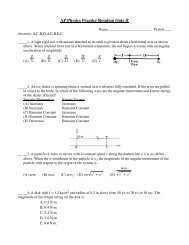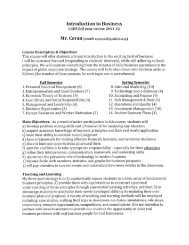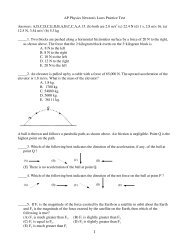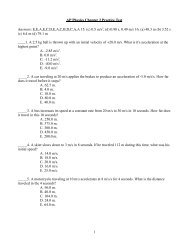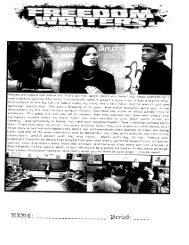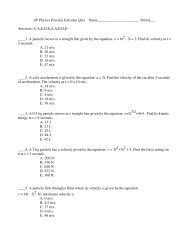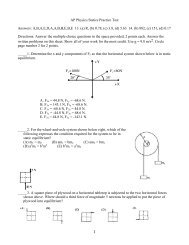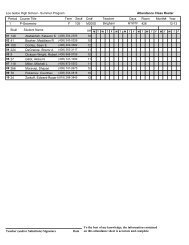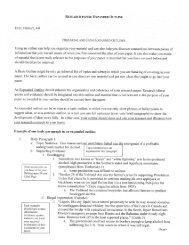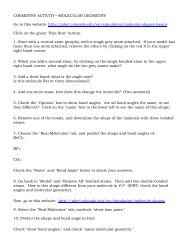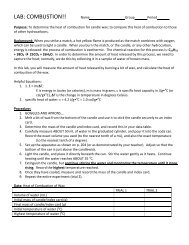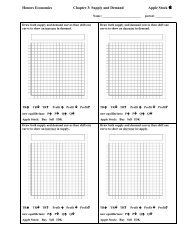AP Physics Energy Practice Test Answers
AP Physics Energy Practice Test Answers
AP Physics Energy Practice Test Answers
- No tags were found...
Create successful ePaper yourself
Turn your PDF publications into a flip-book with our unique Google optimized e-Paper software.
<strong>AP</strong> <strong>Physics</strong> <strong>Energy</strong> <strong>Practice</strong> <strong>Test</strong><strong>Answers</strong>: C,E,C,E,D,B,A,C,C,B,B,A,C,B,D 16. (a) 62.7 J (b) -15.1 J (c) -47.6 J (d) 47.6 J (e) 4.2 m/s17. (a) 450 N (b) 135 J (c) 8.2 m/s (d) 9.49 m/s (e) 9.18 mDirections: You may write on this sheet. For multiple choice write the C<strong>AP</strong>ITAL letter of the bestresponse in the space provided. Answer the other questions in the space provided as completely and asneatly as you can. Show your work and box in your final answers. Use g=9.8 m/s 2 and neglect airresistance unless instructed otherwise._____1. A bucket falls off a 100m high ledge. The bucket's speed when it is 60 m above the ground isA. 6 m/s.B. 17 m/s.C. 28 m/s.D. 34 m/s.E. not enough information._____2. A 4 kg block is moving at 12 m/s on a horizontal frictionless surface. A constant force isapplied that slows it with an acceleration of 3 m/s/s. How much work must this force do to stop theblock?A. 360 J.B. -360 J.C. 576 J.D. -576 J.E. -288 J._____3. A 6.5 kg object encounters a changing force that is graphed Vs distance below. How muchwork was done on the object by this force?A. 30 J.B. 60 J.C. 70 J.D. 80 J.E. 100 J._____4. A helicopter rescues a 105 kg shipwreck survivor by lifting him straight up. The survivormoves 15 m up while his speed drops from 4 m/s to 0. What is the work done on him by the appliedforce?A. 840 J.B. 13755 J.C. 15435 J.D. 16275 J.E. 14595 J.
_____9. From the top of a 70-meter-high building, a l-kilogram ball is thrown directly downward withan initial speed of 10 meters per second. If the ball reaches the ground with a speed of 30 metersper second, the energy lost to friction is most nearly(A) 0J (B) 100 J (C) 300 J ( D) 400 J (E) 700 J_____10. A ball is thrown upward. At a height of 10 meters above the ground, the ball has a potentialenergy of 50 joules (with the potential energy equal to zero at ground level) and is moving upwardwith a kinetic energy of 50 joules. Air friction is negligible. The maximum height reached by theball is most nearly(A) 10 m (B) 20 m (C) 30 m (D) 40 m (E) 50 m_____11. A force F is exerted by a broom handle on the head of the broom, which has a massm. The handle is at an angle θ to the horizontal, as shown below. The work done by theforce on the head of the broom as it moves a distance d across a horizontal floor is(A) Fd sin θ (B) Fd cosθ (C) Fm cosθ (D) Fm tanθ (E) Fmd sinθ_____12. A descending elevator of mass 1,000 kg is uniformly decelerated to rest over a distance of 8m by a cable in which the tension is 11,000 N. The speed v i of the elevator at the beginning of the 8m descent is most nearly(A) 4 m/s (B) 10 m/s (C) 13 m/s (D) 16 m/s (E) 21 m/s
_____13. After a spring is compressed 0.2 m from its uncompressed length it exerts a 20 N force on a0.4 kg block resting on a horizontal frictionless surface. After it is released the block will reach amaximum velocity ofA. 2.1 m/s.B. 100.0 m/s.C. 3.2 m/s.D. 10.0 m/s.E. 6.3 m/s._____14. Shown below are 3 frictionless ramps of equal height. An identical block slides from restdown each ramp to the bottom. Indicate which statements below are true.I. Ramp B will have the greatest speed.II. Ramp C will have the greatest time.III. Ramp A will have the same time as ramp C.A. Statement I only.B. Statement II only.C. Statements I and II only.D. Statement III only.E. Statements I and III only._____15. Three rocks are thrown from a 40 m high cliff, Rock A is thrown at 10 m/s 30 o above thehorizontal, Rock B is thrown 10 m/s horizontally, and Rock C is thrown 10 m/s 30 o below thehorizontal, which rock hits the ground with the greatest speed?A. CB. BC. AD. All 3 hit with the same speedE. A and C tie, B is slower
16. (10 Points) The system shown below is initially at rest. The incline is at an angle of θ = 40 o to thehorizontal and friction is negligible. Block m1 is 4 kg and descends a distance h = 1.6 m to the floor.Block m2 is 1.5 kg and is connected to block m1 by a string of negligible mass. The pulley hasnegligible friction and mass. Answer the following questions.(a) What is the work done on block m1 by its weight?(b) What is the work done on block m2 by its weight?(c) What is the change in potential energy of the 2-block system?(d) What is the change in kinetic energy of the 2-block system?(e) What is the speed of block m1 just before it reaches the floor?
17. (10 Points) A massless spring with force constant k = 750 N/m is fastened at its left end to avertical wall as shown in the figure below. A 3 kg block is pushed so it compresses the spring 0.6 mfrom its uncompressed length. The figure below shows the situation before the spring is compressed.BA0.3 mCFriction0.6 mx=0(a) Determine the force of the spring on the block when the spring is compressed 0.6 m.(b) Determine the elastic potential energy stored in the spring when it is compressed 0.6 m.The block is released from rest when the spring is compressed 0.6 m and is pushed along a horizontalfrictionless surface by the spring.(c) Determine the speed of the block at point A, when the spring is still compressed 0.3 m.(d) Determine the speed of the block at point B, after the spring is no longer compressed.The block encounters a surface with a coefficient of friction µk = 0.5 at point C.(e) Determine how far the block moves beyond point C.




